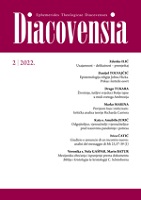Giudizio e annuncio di un incontro nuovo: analisi del messaggio di Mt 23,37-39 (I)
Judgment and announcement of a new meeting: analysis of the message Mt 23, 37–39 (I)
Author(s): Ivica ČatićSubject(s): Biblical studies
Published by: Katolički bogoslovni fakultet u Đakovu
Keywords: Gospel of Matthew; Jesus; Jerusalem; conflict; abandonment; new encounter;
Summary/Abstract: The work, divided into the two following articles, intends to investigate the message of the short passage in Mt 23: 37-39. The importance of research comes from some facts, the first of which is the dramatic relationship between Israel and its Messiah, as presented by the First Evangelist, and from the fact that Mt 23: 37-39 contains the last words of Jesus addressed to the people of 'Israel before the Passion Story. The second fact refers to the unanimity of scholars regarding the message of the text. It presents a crux interpretorum to which conflicting interpretations have been assigned. A first line of the interpreters includes our passage as the announcement of the final salvation; the other, on the other hand, thinks that it is a definitive judgment while the third here finds the message of conditional salvation. In the situation of this disagreement between authoritative researchers, it pushes us to undertake an exhaustive analysis of the text of Mt 23: 37-39 which analyzes every point pertinent to the final message. The result of this research will first offer the basis for proposing our own interpretation and, second, will present the contribution to facilitate understanding of the impact of our text on the whole theology of the Gospel of Matthew. The importance of this theme is also accentuated in the context of recent interreligious dialogue because it could facilitate a step forward towards the truth which, although this is not yet evident today, is unique for all. This first article contains the literary analysis of our pericope. It mainly belongs to reading under the synchronic aspect, although the temporary use of elements of the historical-critical method and analysis in a communicative key is not excluded. The work will examine the remote and immediate context, delimitation and articulation of the text, while the second article continues with semantic analysis.
Journal: Diacovensia: teološki prilozi
- Issue Year: 30/2022
- Issue No: 2
- Page Range: 261-285
- Page Count: 25
- Language: Italian

